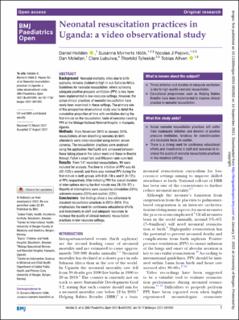| dc.contributor.author | Helldén, Daniel | |
| dc.contributor.author | Höök, Susanna Myrnerts | |
| dc.contributor.author | Pejovic, Nicolas | |
| dc.contributor.author | McLellan, Dan | |
| dc.contributor.author | Lubulwa, Clare | |
| dc.contributor.author | Tylleskär, Thorkild | |
| dc.contributor.author | Alfvén, Tobias | |
| dc.date.accessioned | 2022-02-04T07:35:02Z | |
| dc.date.available | 2022-02-04T07:35:02Z | |
| dc.date.created | 2021-10-06T09:44:59Z | |
| dc.date.issued | 2021 | |
| dc.identifier.issn | 2399-9772 | |
| dc.identifier.uri | https://hdl.handle.net/11250/2977018 | |
| dc.description.abstract | Background
Neonatal mortality, often due to birth asphyxia, remains stubbornly high in sub-Saharan Africa. Guidelines for neonatal resuscitation, where achieving adequate positive pressure ventilation (PPV) is key, have been implemented in low-resource settings. However, the actual clinical practices of neonatal resuscitation have rarely been examined in these settings. The primary aim of this prospective observational study was to detail the cumulative proportion of time with ventilation during the first minute on the resuscitation table of neonates needing PPV at the Mulago National Referral Hospital in Kampala, Uganda.
Methods
From November 2015 to January 2016, resuscitations of non-breathing neonates by birth attendants were video-recorded using motion sensor cameras. The resuscitation practices were analysed using the application NeoTapAS and compared between those taking place in the labour ward and those in theatre through Fisher’s exact test and Wilcoxon rank-sum test.
Results
From 141 recorded resuscitations, 99 were included for analysis. The time to initiation of PPV was 66 (42–102) s overall, and there was minimal PPV during the first minute in both groups with 0 (0–10) s and 0 (0–12) s of PPV, respectively. After initiating PPV the overall duration of interruptions during the first minute was 28 (18–37) s. Majority of interruptions were caused by stimulation (28%), unknown reasons (25%) and suction (22%).
Conclusions
Our findings show a low adherence to standard resuscitation practices in 2015–2016. This emphasises the need for continuous educational efforts and investments in staff and adequate resources to increase the quality of clinical neonatal resuscitation practices in low-resource settings. | en_US |
| dc.language.iso | eng | en_US |
| dc.publisher | BMJ Publishing Group | en_US |
| dc.rights | Navngivelse 4.0 Internasjonal | * |
| dc.rights.uri | http://creativecommons.org/licenses/by/4.0/deed.no | * |
| dc.title | Neonatal resuscitation practices in Uganda: a video observational study | en_US |
| dc.type | Journal article | en_US |
| dc.type | Peer reviewed | en_US |
| dc.description.version | publishedVersion | en_US |
| dc.rights.holder | Copyright Author(s) (or their employer(s)) 2022. | en_US |
| dc.source.articlenumber | e001092 | en_US |
| cristin.ispublished | true | |
| cristin.fulltext | original | |
| cristin.qualitycode | 1 | |
| dc.identifier.doi | 10.1136/bmjpo-2021-001092 | |
| dc.identifier.cristin | 1943663 | |
| dc.source.journal | BMJ Paediatrics Open | en_US |
| dc.identifier.citation | BMJ Paediatrics Open. 2021, 5, e001092. | en_US |
| dc.source.volume | 5 | en_US |

